JAGUAR XJ6 1994 2.G Manual PDF
Manufacturer: JAGUAR, Model Year: 1994, Model line: XJ6, Model: JAGUAR XJ6 1994 2.GPages: 521, PDF Size: 17.35 MB
Page 71 of 521
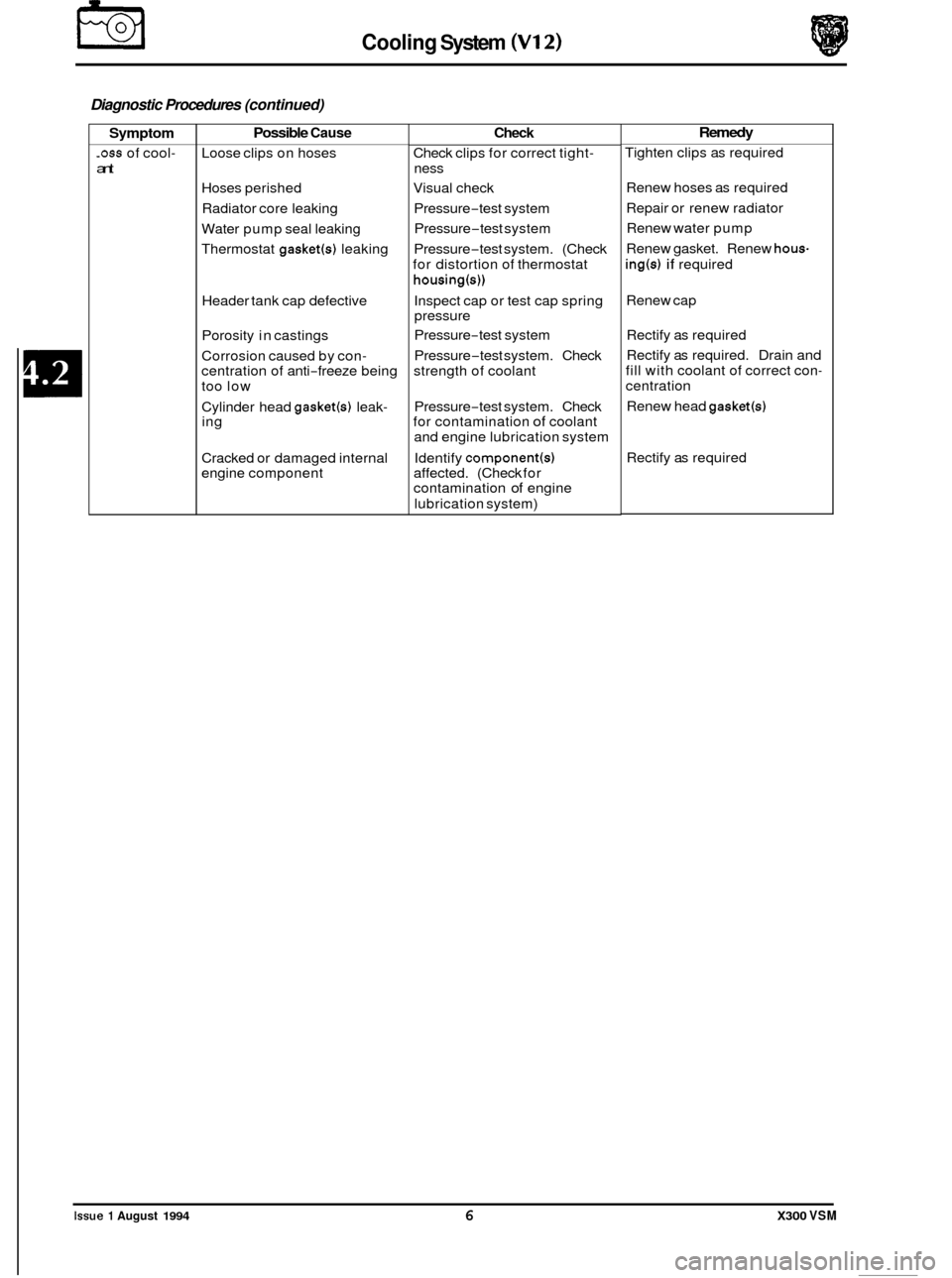
rn Cooling System (VI 2)
Diagnostic Procedures (continued)
Symptom
-0ss of cool-
ant
Possible Cause
Loose clips on hoses
Hoses perished
Radiator core leaking
Water pump seal leaking
Thermostat
gasket(s) leaking
Header tank cap defective
Porosity in castings
Corrosion caused by con
- centration of anti-freeze being
too low
Cylinder head
gasket(4 leak- ing
Cracked or damaged internal
engine component
Check
Check clips for correct tight-
ness
Visual check
Pressure
-test system
Pressure
-test system
Pressure
-test system. (Check
for distortion of thermostat
housing(s))
Inspect cap or test cap spring
pressure
Pressure
-test system
Pressure
-test system. Check
strength of coolant
Pressure
-test system. Check
for contamination of coolant
and engine lubrication system
Identify
component(s) affected. (Check for
contamination of engine
lubrication system)
Remedy
Tighten clips as required
Renew hoses as required
Repair or renew radiator
Renew water pump
Renew gasket. Renew
hous-
ing(s) if required
Renew cap Rectify as required
Rectify as required. Drain and
fill with coolant of correct con
-
centration
Renew head
gasket(s)
Rectify as required
Issue 1 August 1994 6 X300 VSM
Page 72 of 521

SECTION CONTENTS
SutiSection Title SRO Page
I
i . .. . . . . . . . . . . . . . Preliminarypage.. . . . . . . . . . . .. . . . . . . . . .. . .. . . . . .. . . . . .. . . .. . . . . . . . . .. . . . . . . . . ... . . . . . i
5.1.1 . . . . . . . . . . . . . Fuel System layout . . . . . . . . . . . . . . . . . . . . . . . . . . . . . . . . . . . . . . . . . . . . . . . . . . . . . . . . . . . . . . . . . . . 1
5.1.2.. . . . . . . . . . . . &era1 Description . . . . . . . . . . . . . . . . . . . . . . . . . . . . . . . . . . . . . . . . . . . . . . . . . . . . . . . . . . . . . . . . . . 3
5.1.3 . . . . . . . . . . . . . Fuel Rail/ Pressure Regulator Valve/ Injectors
(Supercharged), Renew
. . . . . . . . . . . . . . . . . . . . . . . . . . . . . . . . . . . . . . . . . 18.10.01 18.10.02
19.45.11
19.60.13
............. 5
5.1.4
. . . . . . . . . . . . . Fuel Rail / Pressure Regulator Valve / Injectors
(Normally Aspirated), Renew . . . . . . . . . . . . . . . . . . . . . . . . . . . . . . . . . . . . 18.10.0 1
18.10.02
19.45 11
19.60.13 ............. 7
5.1.5 . . . . . . . . . . . . . Purge Control Valve (All Models), Renew . . . . . . . . . . . . . . . . . . . . . . . . . . 17.15.30 . . . . , . . . . . . . . 9
5.1.6 . . . . . . . . . . . . . Throttle Assembly (Supercharged), Renew . . . . . . . . . . . . . . . . . . . . . . . . . . 18.30.17 1 9.70.04
19.70.07 ............ 10
5.1.7. . . . . . . . . . . . . Idle Speed control Valve/ Gaskets (Supercharged), Renew . . . . . . . . . . . . 18.30.74
18.30.77 ............ 11
5.1.8. . . . . . . . . . . . . idle Speed Control Valve/ Gaskets (Normally Aspirated), Renew . . . . . . 18.30.74
18.30.77
............ 12
5.1.9.
. . . . . . . . . . . . Fuel Cut Off Inertia Switch (All Models), Renew.. . . . . . . . . . . , . . . . . . . . 18.30.35 . . . . . . . . . . . . 13
Page 73 of 521

ii
Page 74 of 521
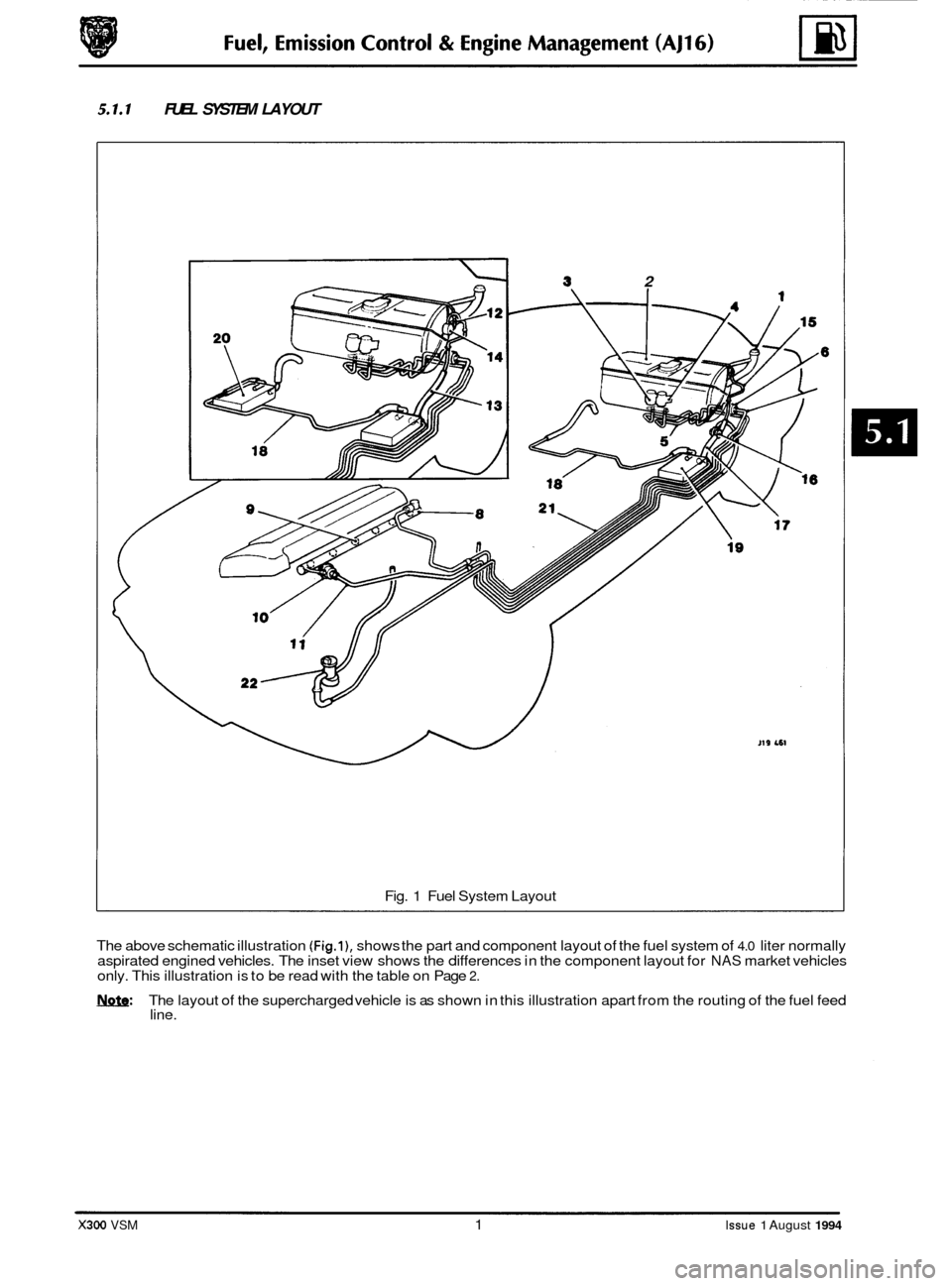
5.1.1 FUEL SYSTEM LAYOUT
0
9 2
Fig. 1 Fuel System Layout
The above schematic illustration
(Fig.l), shows the part and component layout of the fuel system of 4.0 liter normally
aspirated engined vehicles. The inset view shows the differences in the component layout for NAS market vehicles
only. This illustration is to be read with the table on Page 2.
M~Q: The layout of the supercharged vehicle is as shown in this illustration apart from the routing of the fuel feed
line.
X300 VSM 1 Issue 1 August 1994
Page 75 of 521
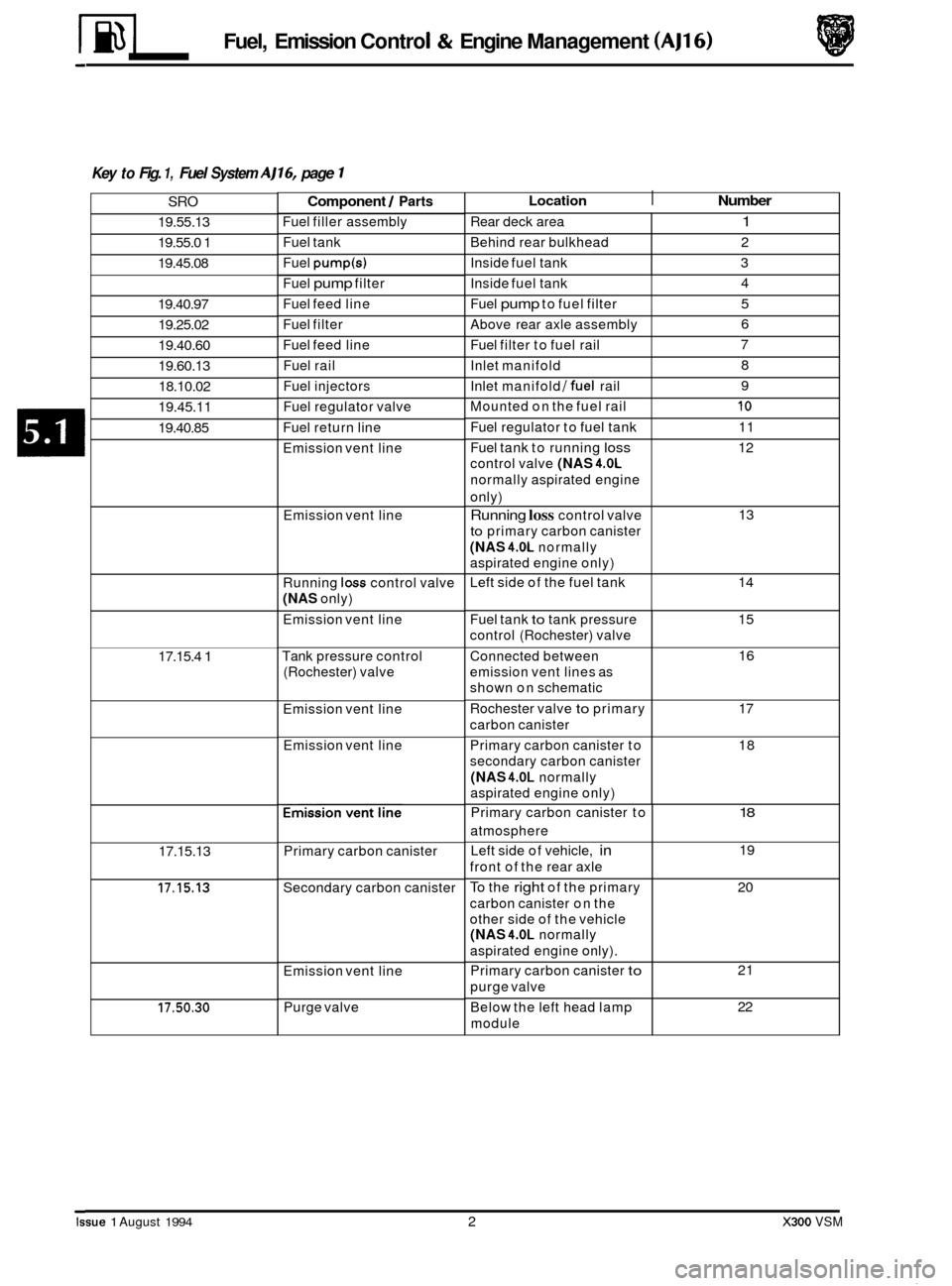
Rear deck area
Behind rear bulkhead
Inside fuel tank 1
2
3
Inside fuel tank
Fuel
pump to fuel filter
Above rear axle assembly
Fuel filter to fuel rail
Inlet manifold
Inlet manifold
/fuel rail
Mounted on the fuel rail
Fuel regulator to fuel tank
Fuel tank to running
loss
control valve (NAS 4.0L
normally aspirated engine
only)
Running loss control valve
to primary carbon canister
(NAS 4.0L normally
aspirated engine only)
Left side of the fuel tank
4
5
6
7 8
9
10
11
12
13
14
Fuel tank to tank pressure
control (Rochester) valve
Connected between
emission vent lines as
shown on schematic
Rochester valve
to primary
carbon canister
Primary carbon canister to
secondary carbon canister
(NAS 4.0L normally
aspirated engine only)
15
16
17
18
Primary carbon canister to
atmosphere
Left side of vehicle,
in
front of the rear axle
To the right of the primary
carbon canister on the
other side of the vehicle
(NAS 4.0L normally
aspirated engine only).
Primary carbon canister
to
purge valve
Below the left head lamp
module
18
19
20
21
22
m Fuel, Emission Contro & Engine Management (AJ16) - .
0
0
0
0
Key to Fig. 1, Fuel System AJ16, page 1
Location I Number Component / Parts
Fuel filler assembly
SRO
19.55.13
19.55.0 1
19.45.08
Fuel tank
Fuel
pump(s)
Fuel pump filter
Fuel feed line
Fuel filter
Fuel feed line
19.40.97
19.25.02
19.40.60
19.60.13 18.10.02
19.45.11
Fuel rail
Fuel injectors
Fuel regulator valve
19.40.85 Fuel return line
Emission vent line
Emission vent line
Running
loss control valve
(NAS only)
Emission vent line
Tank pressure control
(Rochester) valve
17.15.4 1
Emission vent line
Emission vent line
Emission vent line
Primary carbon canister
17.15.13
Secondary carbon canister 17.15.13
Emission vent line
Purge valve
17.50.30
Issue 1 August 1994 2 X300 VSM
Page 76 of 521
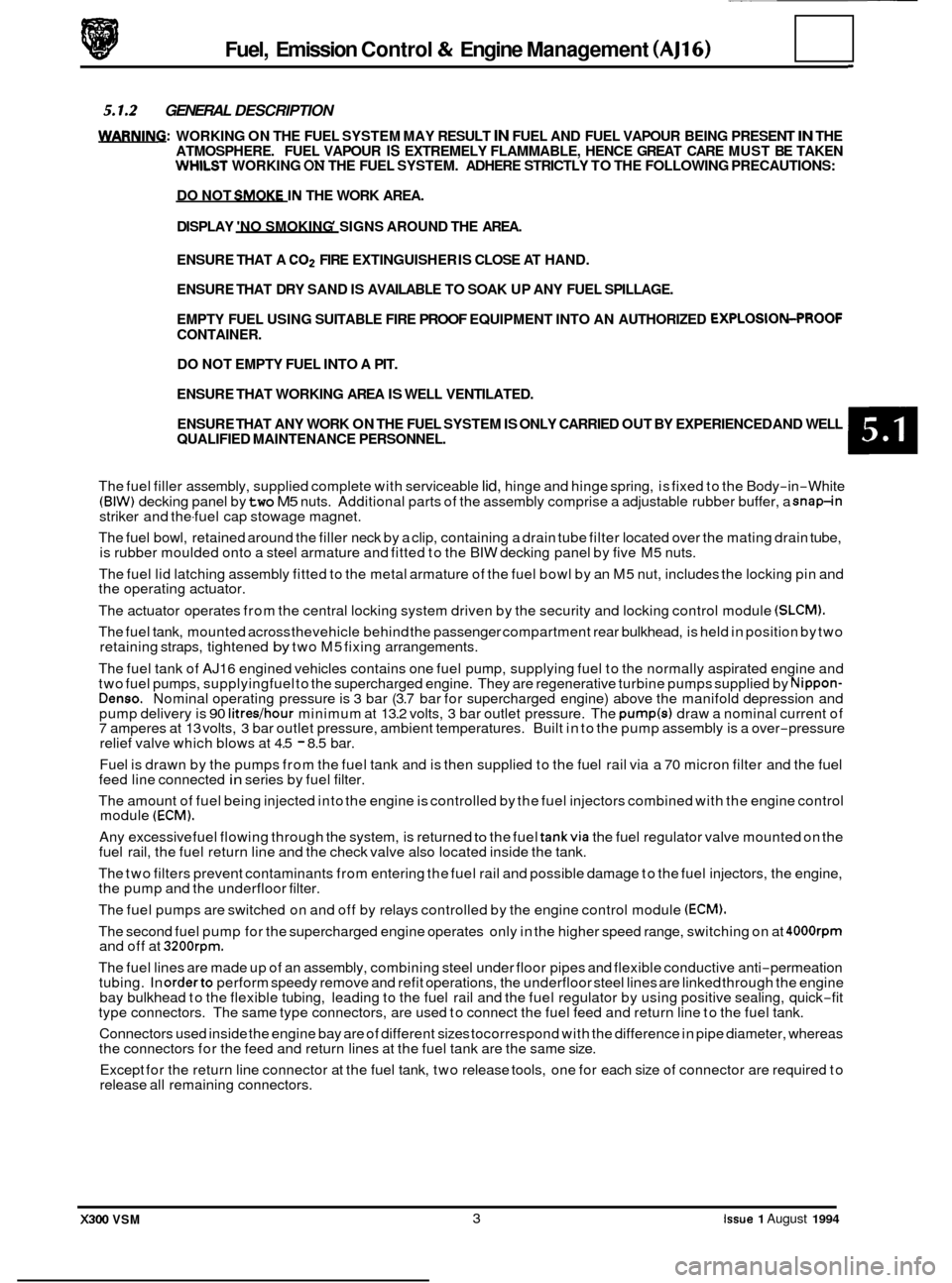
striker and the-fuel cap stowage magnet.
The fuel bowl, retained around the filler neck by a clip, containing a drain tube filter located over the mating drain tube,
is rubber moulded onto a steel armature and fitted to the BIW decking panel by five M5 nuts.
The fuel lid latching assembly fitted to the metal armature of the fuel bowl by an M5 nut, includes the locking pin and
the operating actuator.
The actuator operates from the central locking system driven by the security and locking control module
(SLCM).
The fuel tank, mounted across thevehicle behind the passenger compartment rear bulkhead, is held in position by two
retaining straps, tightened by two M5 fixing arrangements.
The fuel tank of AJ16 engined vehicles contains one fuel pump, supplying fuel to the normally aspirated engine and
two fuel pumps, supplyingfuel to the supercharged engine. They are regenerative turbine pumps supplied by
Nippon- Denso. Nominal operating pressure is 3 bar (3.7 bar for supercharged engine) above the manifold depression and
pump delivery is 90 litredhour minimum at 13.2 volts, 3 bar outlet pressure. The pump(s) draw a nominal current of 7 amperes at 13 volts, 3 bar outlet pressure, ambient temperatures. Built in to the pump assembly is a over-pressure
relief valve which blows at 4.5 - 8.5 bar.
Fuel is drawn by the pumps from the fuel tank and is then supplied to the fuel rail via a
70 micron filter and the fuel
feed line connected in series by fuel filter.
The amount of fuel being injected into the engine
is controlled by the fuel injectors combined with the engine control module (ECM). - Any excessive fuel flowing through the system, is returned to the fuel tankvia the fuel regulator valve mounted on the
fuel rail, the fuel return line and the check valve also located inside the tank.
The two filters prevent contaminants from entering the fuel rail and possible damage to the fuel injectors, the engine,
the pump and the underfloor filter.
The fuel pumps are switched on and off by relays controlled by the engine control module
(ECM).
The second fuel pump for the supercharged engine operates only in the higher speed range, switching on at 4000rpm and off at 3200rpm.
The fuel lines are made up of an assembly, combining steel under floor pipes and flexible conductive anti-permeation
tubing. In orderto perform speedy remove and refit operations, the underfloor steel lines are linked through the engine
bay bulkhead to the flexible tubing, leading to the fuel rail and the fuel regulator by using positive sealing, quick-fit
type connectors. The same type connectors, are used to connect the fuel feed and return line to the fuel tank.
Connectors used inside the engine bay are of different sizes tocorrespond with the difference in pipe diameter, whereas
the connectors for the feed and return lines at the fuel tank are the same size.
Except for the return line connector at the fuel tank, two release tools, one for each size of connector are required to
release all remaining connectors.
-~
Fuel, Emission Control & Engine Management (AJ16)
5.1.2 GENERAL DESCRIPTION
m: WORKING ON THE FUEL SYSTEM MAY RESULT IN FUEL AND FUEL VAPOUR BEING PRESENT IN THE
ATMOSPHERE. FUEL VAPOUR IS EXTREMELY FLAMMABLE, HENCE GREAT CARE MUST BE TAKEN WHllST WORKING ON THE FUEL SYSTEM. ADHERE STRICTLY TO THE FOLLOWING PRECAUTIONS:
DO NOT
SMOEIN THE WORK AREA.
DISPLAY 'NO SMOKING
' SIGNS AROUND THE AREA.
ENSURE THAT A
CO2 FIRE EXTINGUISHER IS CLOSE AT HAND.
ENSURE THAT DRY SAND
IS AVAILABLE TO SOAK UP ANY FUEL SPILLAGE.
EMPTY FUEL USING SUITABLE FIRE
PROOF EQUIPMENT INTO AN AUTHORIZED EXPLOSIOWROOF
CONTAINER.
DO NOT EMPTY FUEL
INTO A PIT.
ENSURE THAT WORKING AREA
IS WELL VENTILATED.
ENSURE THAT ANY WORK ON THE FUEL SYSTEM
IS ONLY CARRIED OUT BY EXPERIENCED AND WELL
QUALIFIED MAINTENANCE PERSONNEL.
The fuel filler assembly, supplied complete with serviceable lid, hinge and hinge spring, is fixed to the Body-in-White
(BIW) decking panel by two M5 nuts. Additional parts of the assembly comprise a adjustable rubber buffer, a snap-in
X300 VSM 3 Issue 1 August 1994
Page 77 of 521
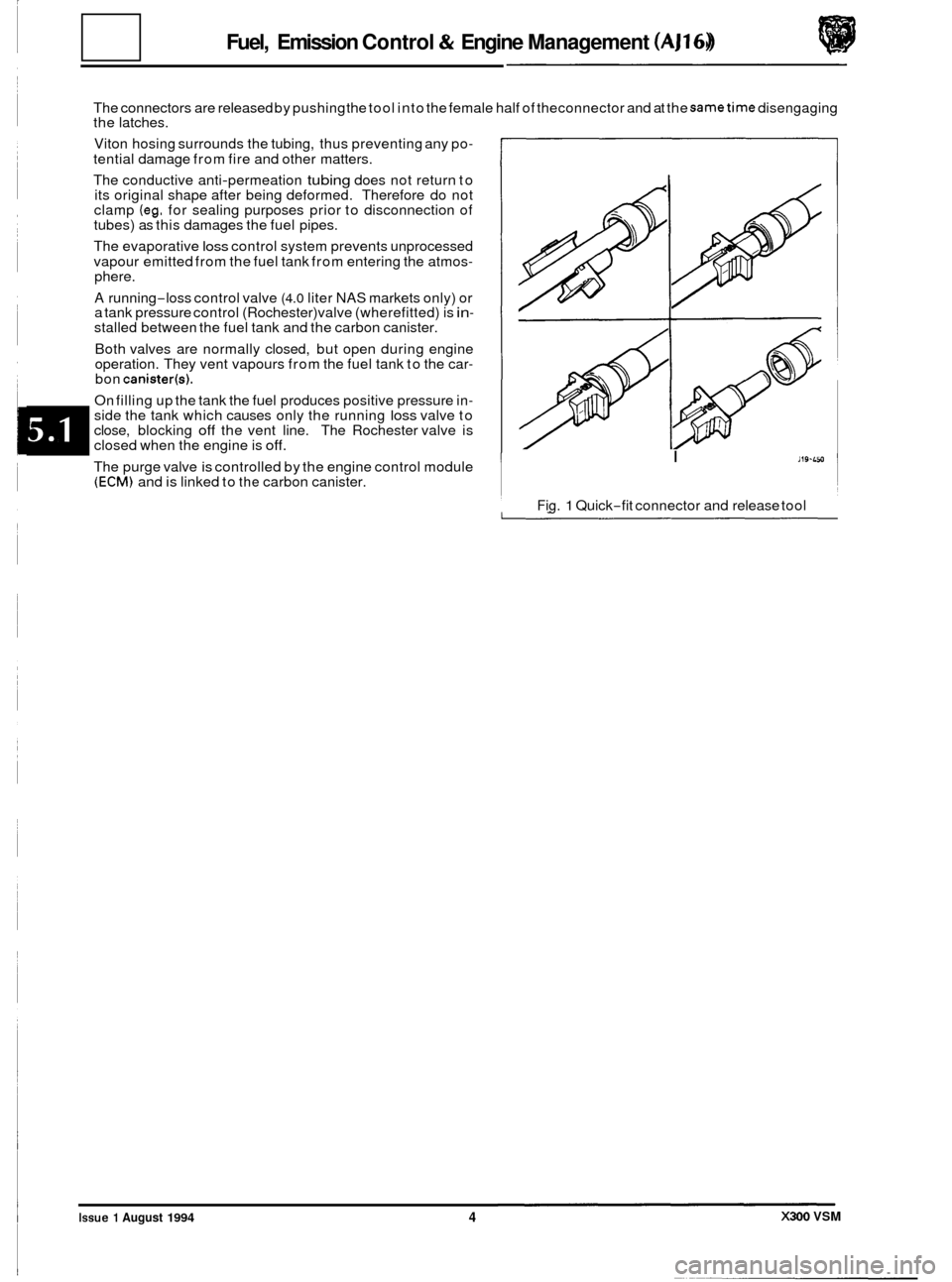
Fuel, Emission Control & Engine Management (AJl6)
0
The connectors are released by pushing the tool in to the female half of theconnector and at the sametime disengaging
the latches.
Viton hosing surrounds the tubing, thus preventing any po
-
tential damage from fire and other matters.
The conductive anti
-permeation tubing does not return to
its original shape after being deformed. Therefore do not
clamp
(eg. for sealing purposes prior to disconnection of
tubes) as this damages the fuel pipes.
The evaporative
loss control system prevents unprocessed
vapour emitted from the fuel tank from entering the atmos
- phere.
A running-loss control valve (4.0 liter NAS markets only) or
a tank pressure control (Rochester) valve (wherefitted) is in- stalled between the fuel tank and the carbon canister.
Both valves are normally closed, but open during engine
operation. They vent vapours from the fuel tank to the car
- bon canisterb).
On filling up the tank the fuel produces positive pressure in- side the tank which causes only the running loss valve to
close, blocking off the vent line. The Rochester valve is
closed when the engine is off.
The purge valve is controlled by the engine control module (ECM) and is linked to the carbon canister.
I Jl9-LM
Fig. 1 Quick-fit connector and release tool
0
0
0
X300 VSM Issue 1 August 1994 4
Page 78 of 521
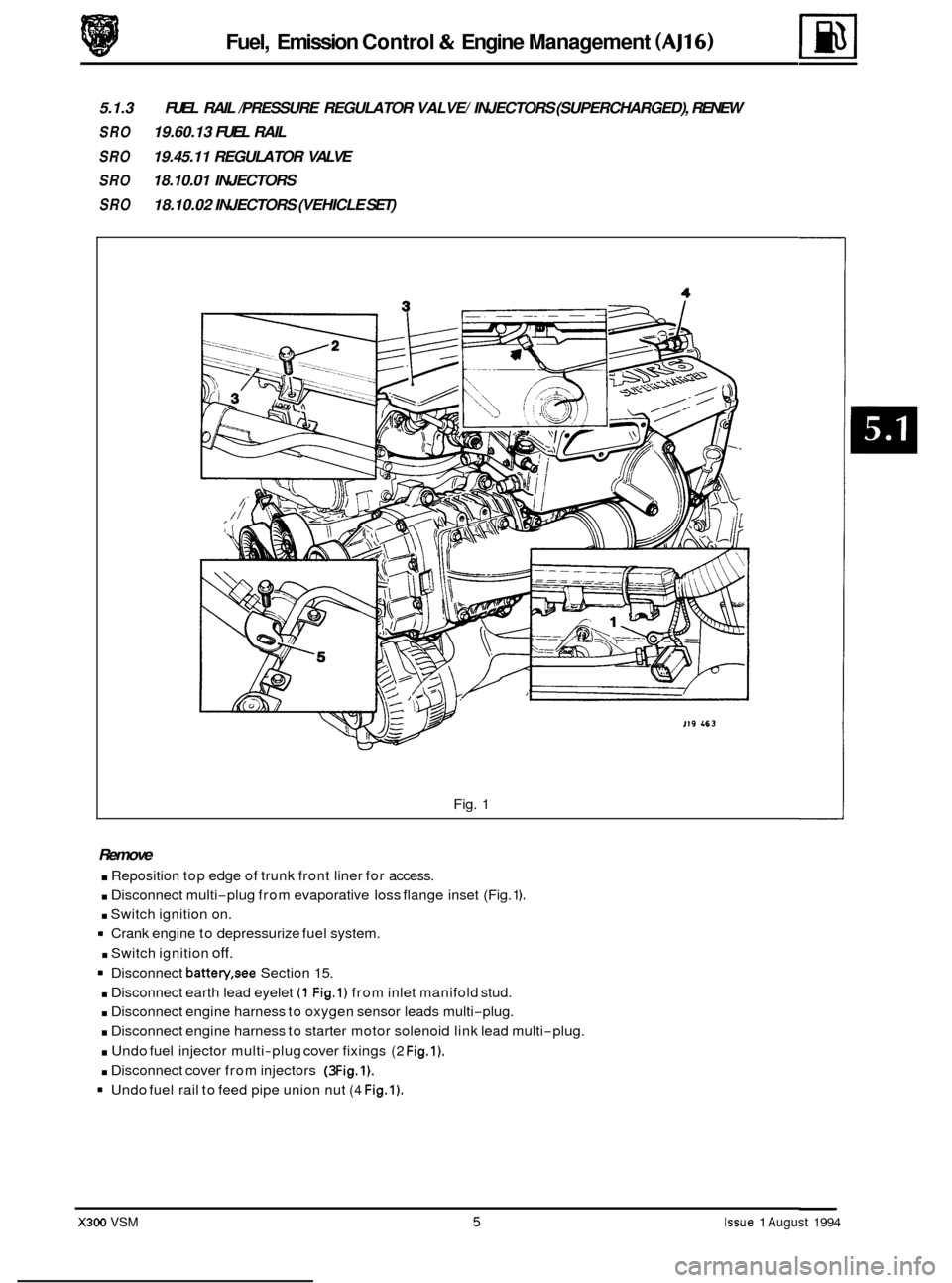
Fuel, Emission Control & Engine Management (AJ16)
5.1.3
SRO 19.60.13 FUEL RAIL
SRO 19.45.11 REGULATOR VALVE
SRO 18.10.01 INJECTORS
SRO 18.10.02 INJECTORS (VEHICLE SET)
FUEL
RAIL /PRESSURE REGULATOR VALVE/ INJECTORS (SUPERCHARGED), RENEW
Fig. 1
Remove
. Reposition top edge of trunk front liner for access.
. Disconnect multi-plug from evaporative loss flange inset (Fig. 1 ).
. Switch ignition on.
. Switch ignition off.
. Disconnect earth lead eyelet (1 Fig.1) from inlet manifold stud.
. Disconnect engine harness to oxygen sensor leads multi-plug.
. Disconnect engine harness to starter motor solenoid link lead multi-plug.
. Undo fuel injector multi-plug cover fixings (2 Fig.1).
. Disconnect cover from injectors (3 Fig.1).
Crank engine to depressurize fuel system.
Disconnect
battery,see Section 15.
Undo fuel rail to feed pipe union nut
(4 Fig.1).
X300 VSM 5 Issue 1 August 1994
Page 79 of 521
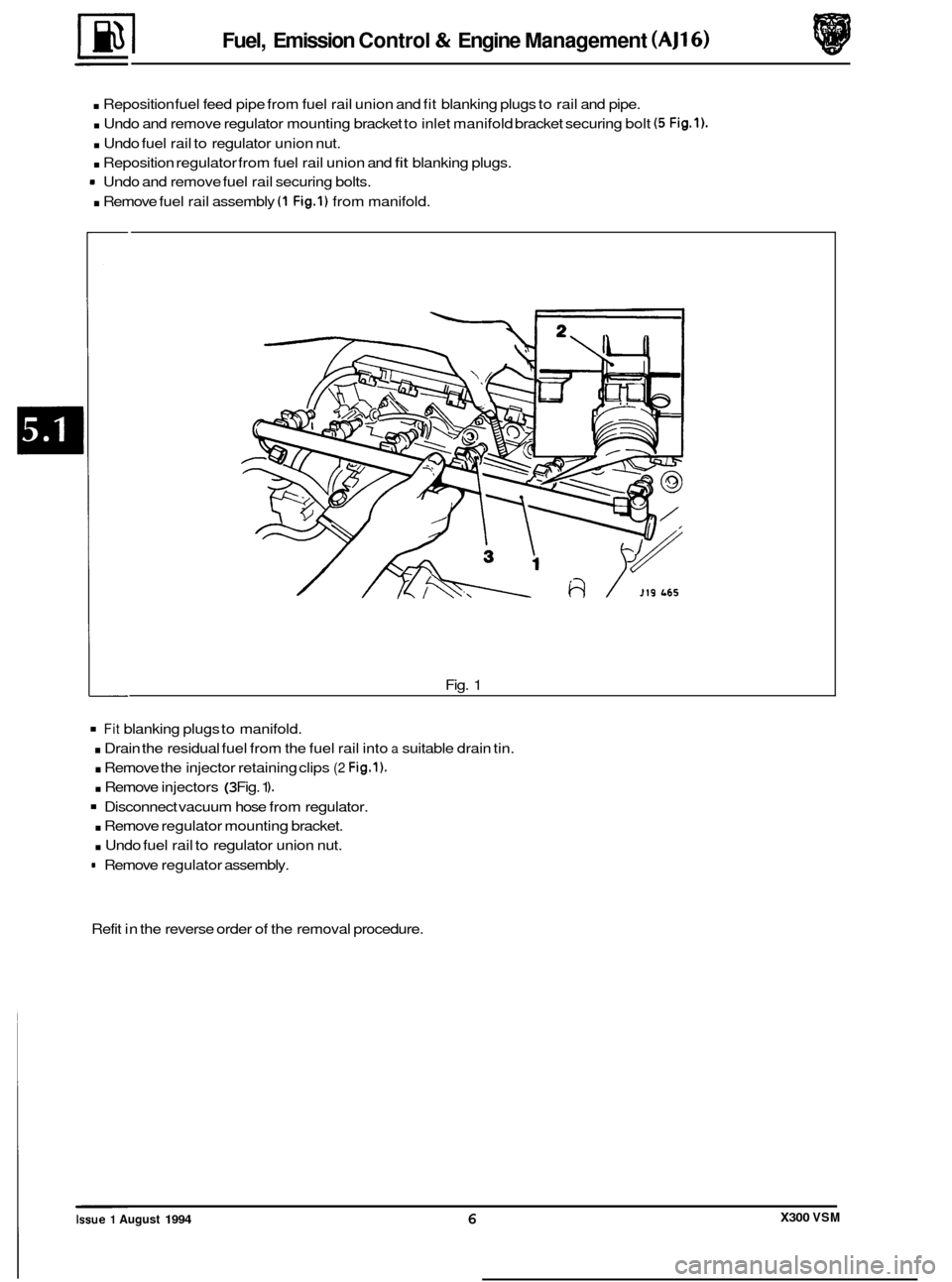
Fuel, Emission Control & Engine Management (AJ16)
. Reposition fuel feed pipe from fuel rail union and fit blanking plugs to rail and pipe.
. Undo and remove regulator mounting bracket to inlet manifold bracket securing bolt (5 Fig.1).
. Undo fuel rail to regulator union nut.
. Reposition regulator from fuel rail union and fit blanking plugs.
. Remove fuel rail assembly (1 Fig.1) from manifold.
Undo
and remove fuel rail securing bolts.
Fig. 1
Fit blanking plugs to manifold.
. Drain the residual fuel from the fuel rail into a suitable drain tin.
. Remove the injector retaining clips (2 Fig.1).
. Remove injectors (3 Fig. 1 ).
Disconnect vacuum hose from regulator.
. Remove regulator mounting bracket.
. Undo fuel rail to regulator union nut.
= Remove regulator assembly.
Refit in the reverse order of the removal procedure.
X300 VSM Issue 1 August 1994 6
Page 80 of 521
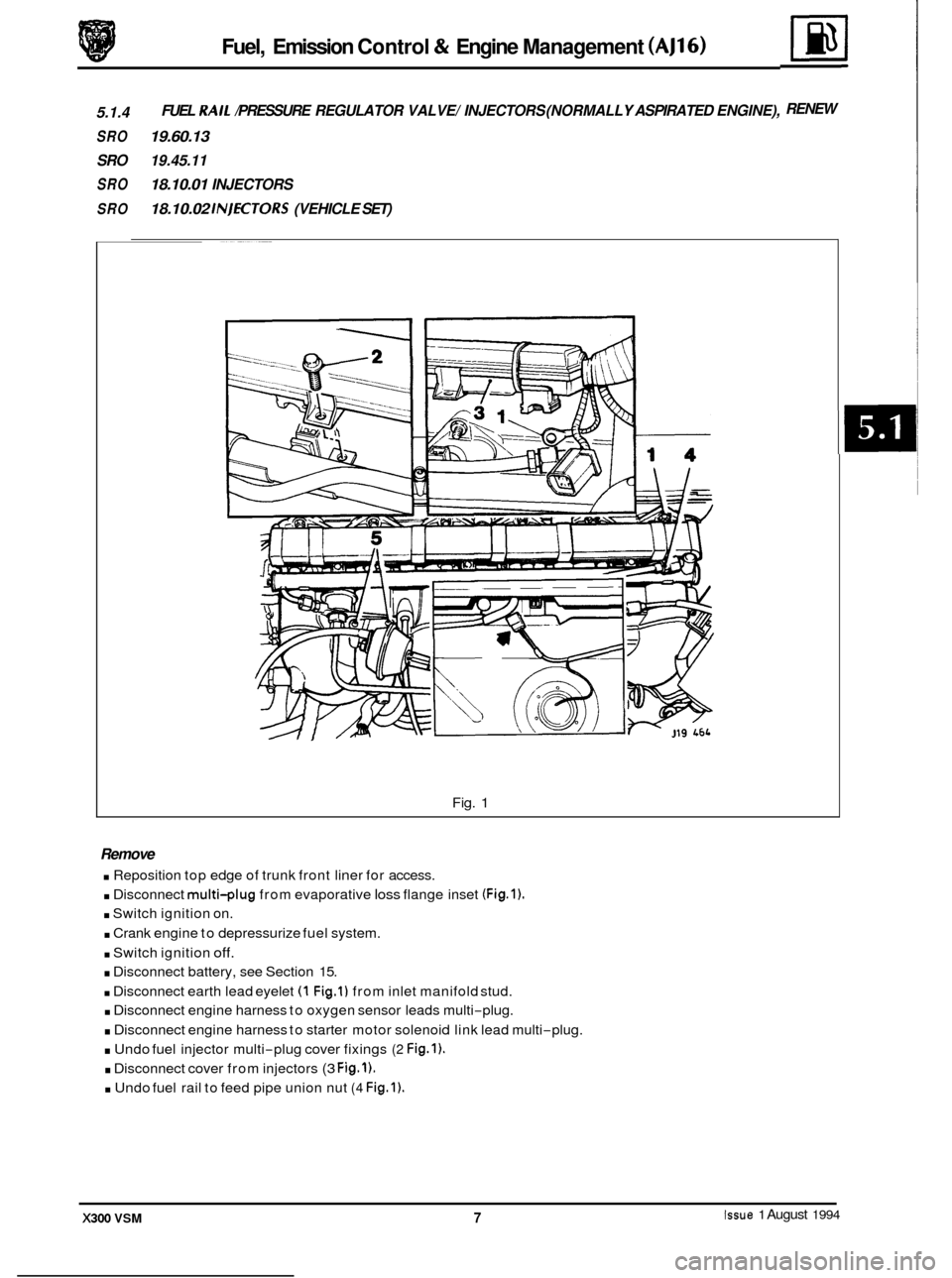
Fuel, Emission Control & Engine Management (AJ16)
5.1.4
SRO 19.60.13
FUEL RAIL /PRESSURE REGULATOR VALVE/ INJECTORS (NORMALLY ASPIRATED ENGINE),
SRO 19.45.11
SRO 18.10.01 INJECTORS
SRO 18.10.02 INIECTORS (VEHICLE SET)
IB
RENEW
Fig. 1
Remove
. Reposition top edge of trunk front liner for access.
. Disconnect multi-plug from evaporative loss flange inset (Fig.1).
. Switch ignition on.
. Crank engine to depressurize fuel system.
. Switch ignition off.
. Disconnect battery, see Section 15.
. Disconnect earth lead eyelet (1 Fig.1) from inlet manifold stud.
. Disconnect engine harness to oxygen sensor leads multi-plug.
. Disconnect engine harness to starter motor solenoid link lead multi-plug.
. Undo fuel injector multi-plug cover fixings (2 Fig.1).
. Disconnect cover from injectors (3 Fig.1).
. Undo fuel rail to feed pipe union nut (4 Fig.1).
Issue 1 August 1994 X300 VSM 7